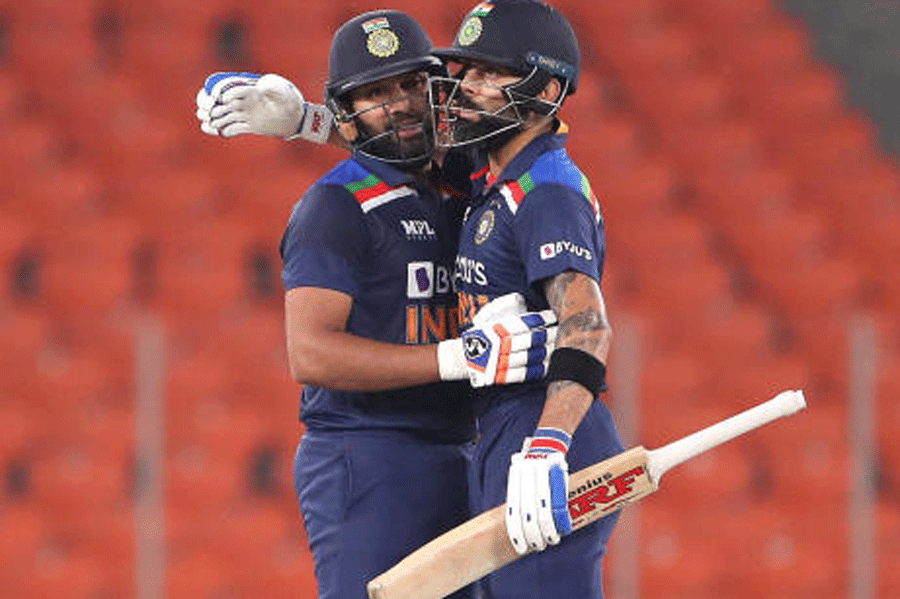Virat Kohli can’t explain what happened that night at the Melbourne Cricket Ground and reaffirms it “won’t happen ever again”.
Months after his indelible 82 not out off 98 balls against Pakistan, an innings which sent even Sunil Gavaskar jumping in delight, Kohli had revealed that his “mind had shut off completely by the 12th or 13th over”. He was in a different zone once he ran out Axar Patel to reduce India to 31/4 in the seventh over in their quest for 160.
Kohli was 5 off 10 balls then and he “felt like something higher was guiding” him. India needed 31 off the last 12 balls but Kohli made it possible in a nerve-racking finish.
He had two more innings of intent in the tournament with a strike rate of above 140 but had to bear the brunt of criticism following the loss to England in the semi-final. A half-century with a strike-rate of 125 was considered below par and the selectors felt it was time to experiment with youngsters in the shortest format.
India learnt their lessons in successive World Cups: their top-order was too slow and their tactics outdated. There was the need for a change in mindset as there was no role for an anchor.
Hardik Pandya was put in charge and the likes of Rohit Sharma, Kohli and KL Rahul were shunted out of the T20 side. Almost 14 months later, Rohit and Kohli have earned a recall for the series against Afghanistan.
Given the selectors’ thinking and the players’ star status, it is all but certain that they will keep their places for the World Cup.
The vacuum created in the leadership role following injuries to Pandya and Suryakumar Yadav has opened the doors for Rohit. The selectors aren’t keen on risking the injury-prone Pandya ahead of the showpiece event while Surya is considered capable only in a stand-in capacity.
Captaining in a World Cup involves a lot of pressure besides the display of technical
manoeuvrings and Rohit has been a proven taskmaster.
But can he still add value in this format?
If his explosive and fearless batting in the ODI World Cup is considered the benchmark, is he capable of replicating such form in the T20 Powerplay overs? He hasn’t had a strike-rate of around 140 since 2018 in T20s. He has also hardly been enterprising in the last two editions of the T20 World Cups and the IPL.
Anything can happen in T20s and there’s hope that the enormity of the occasion will spur on the Team India captain. He has shown the versatility to adjust to the conditions and the selectors are counting on his abilities.
Once Rohit was picked, it was hard to ignore Kohli. The selectors were in two minds but a prompt from the Board forced them to fall in line.
Kohli had been India’s highest run-getter in the last World Cup but a strike-rate of 136.40 was the talking point. There’s none comparable when it comes to chasing targets but concerns have been repeatedly raised when India bat first.
He doesn’t possess the flourish and spontaneity of a Surya. Kohli’s record against the the spinners in the middle-overs hasn’t been encouraging either. One way of making him more effective could be by allowing him to open with Rohit. If Kohli bats at No. 3, Surya has to come in at No. 4 which makes both their positions challenging.
Kohli has been batting with a swagger which only he can since his record 765 runs from 11 matches in the World Cup at home. But including both the players will mean the enterprising Yashasvi Jaiswal, Tilak Varma, Shreyas Iyer or a finisher like Rinku Singh missing out. The line-up will be more predictable as the ploy of using the left-right combination to unsettle the bowlers will be absent.
India’s top-order has regularly faltered in the last two World Cups when batting first. There were calls for a change to shed the conservative batting and adopt a more dynamic approach in keeping with the demands of the format. But the selectors seem to have again treaded the same path.
Rohit and Kohli’s inclusion can be a double-edged sword for them. Success in the World Cup will work in their favour but any reverses could have grave implications. For now there’s hope but the selectors have taken a huge gamble.










